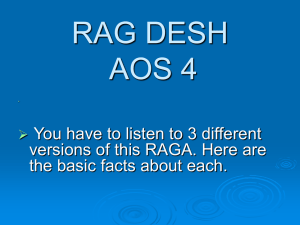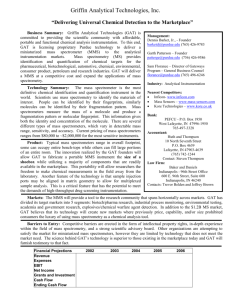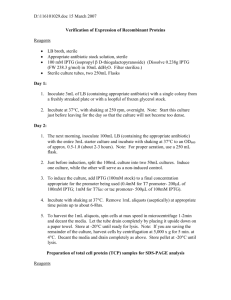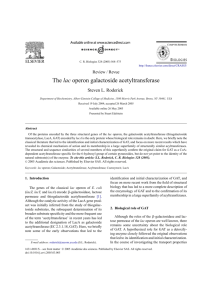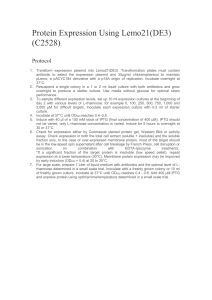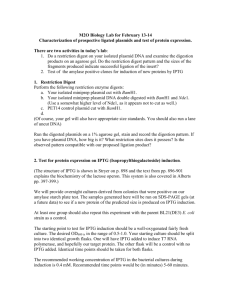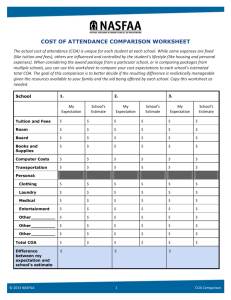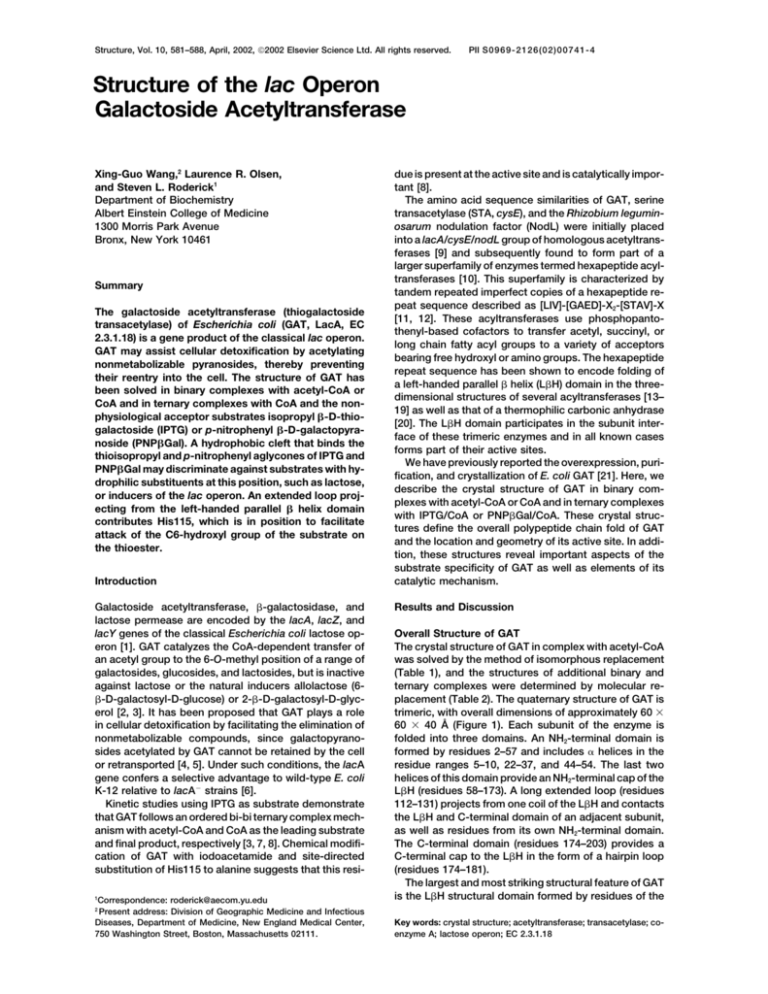
Structure, Vol. 10, 581–588, April, 2002, 2002 Elsevier Science Ltd. All rights reserved.
PII S0969-2126(02)00741-4
Structure of the lac Operon
Galactoside Acetyltransferase
Xing-Guo Wang,2 Laurence R. Olsen,
and Steven L. Roderick1
Department of Biochemistry
Albert Einstein College of Medicine
1300 Morris Park Avenue
Bronx, New York 10461
Summary
The galactoside acetyltransferase (thiogalactoside
transacetylase) of Escherichia coli (GAT, LacA, EC
2.3.1.18) is a gene product of the classical lac operon.
GAT may assist cellular detoxification by acetylating
nonmetabolizable pyranosides, thereby preventing
their reentry into the cell. The structure of GAT has
been solved in binary complexes with acetyl-CoA or
CoA and in ternary complexes with CoA and the nonphysiological acceptor substrates isopropyl -D-thiogalactoside (IPTG) or p-nitrophenyl -D-galactopyranoside (PNPGal). A hydrophobic cleft that binds the
thioisopropyl and p-nitrophenyl aglycones of IPTG and
PNPGal may discriminate against substrates with hydrophilic substituents at this position, such as lactose,
or inducers of the lac operon. An extended loop projecting from the left-handed parallel  helix domain
contributes His115, which is in position to facilitate
attack of the C6-hydroxyl group of the substrate on
the thioester.
Introduction
Galactoside acetyltransferase, -galactosidase, and
lactose permease are encoded by the lacA, lacZ, and
lacY genes of the classical Escherichia coli lactose operon [1]. GAT catalyzes the CoA-dependent transfer of
an acetyl group to the 6-O-methyl position of a range of
galactosides, glucosides, and lactosides, but is inactive
against lactose or the natural inducers allolactose (6-D-galactosyl-D-glucose) or 2--D-galactosyl-D-glycerol [2, 3]. It has been proposed that GAT plays a role
in cellular detoxification by facilitating the elimination of
nonmetabolizable compounds, since galactopyranosides acetylated by GAT cannot be retained by the cell
or retransported [4, 5]. Under such conditions, the lacA
gene confers a selective advantage to wild-type E. coli
K-12 relative to lacA⫺ strains [6].
Kinetic studies using IPTG as substrate demonstrate
that GAT follows an ordered bi-bi ternary complex mechanism with acetyl-CoA and CoA as the leading substrate
and final product, respectively [3, 7, 8]. Chemical modification of GAT with iodoacetamide and site-directed
substitution of His115 to alanine suggests that this resi1
Correspondence: roderick@aecom.yu.edu
Present address: Division of Geographic Medicine and Infectious
Diseases, Department of Medicine, New England Medical Center,
750 Washington Street, Boston, Massachusetts 02111.
due is present at the active site and is catalytically important [8].
The amino acid sequence similarities of GAT, serine
transacetylase (STA, cysE), and the Rhizobium leguminosarum nodulation factor (NodL) were initially placed
into a lacA/cysE/nodL group of homologous acetyltransferases [9] and subsequently found to form part of a
larger superfamily of enzymes termed hexapeptide acyltransferases [10]. This superfamily is characterized by
tandem repeated imperfect copies of a hexapeptide repeat sequence described as [LIV]-[GAED]-X2-[STAV]-X
[11, 12]. These acyltransferases use phosphopantothenyl-based cofactors to transfer acetyl, succinyl, or
long chain fatty acyl groups to a variety of acceptors
bearing free hydroxyl or amino groups. The hexapeptide
repeat sequence has been shown to encode folding of
a left-handed parallel  helix (LH) domain in the threedimensional structures of several acyltransferases [13–
19] as well as that of a thermophilic carbonic anhydrase
[20]. The LH domain participates in the subunit interface of these trimeric enzymes and in all known cases
forms part of their active sites.
We have previously reported the overexpression, purification, and crystallization of E. coli GAT [21]. Here, we
describe the crystal structure of GAT in binary complexes with acetyl-CoA or CoA and in ternary complexes
with IPTG/CoA or PNPGal/CoA. These crystal structures define the overall polypeptide chain fold of GAT
and the location and geometry of its active site. In addition, these structures reveal important aspects of the
substrate specificity of GAT as well as elements of its
catalytic mechanism.
Results and Discussion
Overall Structure of GAT
The crystal structure of GAT in complex with acetyl-CoA
was solved by the method of isomorphous replacement
(Table 1), and the structures of additional binary and
ternary complexes were determined by molecular replacement (Table 2). The quaternary structure of GAT is
trimeric, with overall dimensions of approximately 60 ⫻
60 ⫻ 40 Å (Figure 1). Each subunit of the enzyme is
folded into three domains. An NH2-terminal domain is
formed by residues 2–57 and includes ␣ helices in the
residue ranges 5–10, 22–37, and 44–54. The last two
helices of this domain provide an NH2-terminal cap of the
LH (residues 58–173). A long extended loop (residues
112–131) projects from one coil of the LH and contacts
the LH and C-terminal domain of an adjacent subunit,
as well as residues from its own NH2-terminal domain.
The C-terminal domain (residues 174–203) provides a
C-terminal cap to the LH in the form of a hairpin loop
(residues 174–181).
The largest and most striking structural feature of GAT
is the LH structural domain formed by residues of the
2
Key words: crystal structure; acetyltransferase; transacetylase; coenzyme A; lactose operon; EC 2.3.1.18
Structure
582
Table 1. Multiple Isomorphous Replacement Phasing Statistics
Data
Resolution (Å)
Unique
Observed
Completenessa
Rmerge (%)b
Riso (%)c
fc/LOCd
RCullise
Native
PHMPS
TMLA
2.5
2.8
2.8
23094
17101
17202
93716
79002
60537
0.90
0.93
0.94
8.9
9.7
8.5
⫺
24.3
21.9
⫺
1.87
2.94
⫺
0.57
0.43
Overall figure-of-merit for 18287 reflections (0.99 complete) to 2.8 Å resolution ⫽ 0.42. The data sets are GAT/acetyl-CoA (Native) and the
PHMPS and TMLA heavy atom derivatives.
a
Completeness is the ratio of the number of observed unique reflections to the total number of theoretically possible reflections.
b
Rmerge ⫽ ⌺|Ii ⫺ ⬍I⬎|/⌺|Ii| ⫻ 100 where Ii is an individual intensity observation, ⬍I⬎ is the mean intensity for that reflection and the summation
is over all reflections.
c
Riso ⫽ ⌺ |FNat ⫺ FDer||/⌺|FNat| ⫻ 100 between native and heavy atom derivative data sets.
d
fc/LOC ⫽ RMS heavy atom structure factor amplitude/RMS lack-of-closure.
e
RCullis ⫽ ⌺||fH,obs| ⫺ |fH,calc||/⌺||fH,obs|| calculated for centric reflections.
hexapeptide repeat amino acid sequence. The polypeptide chain of this domain is composed of 5.3 coils as if
wound in a left-handed sense around the surface of an
equilateral prism. The faces of this prism are parallel 
sheets formed by unusual left-handed crossover connections [22, 23] between short  strands. The hexapeptide repeat sequence residue types can be assigned a
nomenclature such that the six residues of the canonical
hexapeptide sequence [LIV]-[GAED]-X2-[STAV]-X are
termed i, i⫹1, . . . i⫹5. The arrangement of coils in the
LH domain places equivalent residue types on top of
one another in stacks (Figures 1C and 2) and relates
adjacent coils by a translation equal to the 4.9 Å distance
separating its parallel  strands.
Although each coil of an LH domain may be composed of just three hexapeptide repeats, the length of
each coil frequently differs from the canonical length of
18 residues due to variation in the number of amino
acids inserted in the T3 turn of each coil (Figure 2). These
insertions in coils C1, C2, and C3 do not disrupt the
hydrogen bonding pattern of the flat parallel  sheets
that form the planar faces of the LH domain. Such T3
loops are a common but distinctive structural feature of
hexapeptide acyltransferases and have been shown to
donate residues to the active sites of tetrahydrodipicolinate N-succinyltransferase (DapD) [14], a xenobiotic
acetyltransferase (PaXAT) [15], and a bifunctional uridyltransferase/pyrophosphorylase (GlmU) [17–19]. These
loops represent a means by which hexapeptide acyltransferases acquire structural and functional diversity in
the context of the structurally invariant LH domain.
The longest T3 loop of GAT projects from coil C3 and
corresponds to 18 residues inserted in the range 112–
131 that lengthen a 2 residue turn (Figure 2). Similarly,
the extended T3 loop of PaXAT corresponds to 36 additional residues inserted in the range 72–110 which
lengthen the 3 residue T3 turn at this position. It is possible that the long external loops of both enzymes could
Table 2. Data Measurement and Structure Refinement Statistics for GAT Complexes
Data Measurement
Resolution (Å)
Observed reflections
Unique reflections
Redundancy
Rmerge (%)a,b
Completeness (%)c
Atoms
Protein atoms
Substrate atoms
Water molecules
Rms deviation from ideality
Bond lengths (Å)
Bond angles (⬚)
Average thermal factor (Å2)
Protein atoms
Substrate/cofactor atoms
Solvent atoms
Rfree (%)d
Rfactor (%)e
Acetyl-CoA
CoA
IPTG/CoA
PNPGal/CoA
2.5
93176
23094
4.0
8.9 (29.8)
90.1 (68.8)
3.2
69299
12072
5.7
12.7 (24.3)
96.0 (79.4)
2.8
65103
17213
3.8
8.8 (23.1)
92.2 (67.5)
2.8
77286
17605
4.4
11.0 (20.1)
94.1 (69.1)
4713
153
113
4713
144
–
4755
90/144
95
4752
63/144
72
0.011
3.0
0.011
3.0
0.008
1.4
0.010
1.4
21.0
41.6
27.4
24.8 (33.2)
19.3 (25.2)
17.0
36.2
–
22.2 (27.3)
19.5 (22.9)
16.9
42.7/33.5
27.5
24.7 (20.8)
17.2 (24.4)
19.8
45.9/40.8
29.0
25.3 (22.0)
17.4 (29.1)
Rmerge (%) ⫽ ⌺|Ii ⫺ ⬍I⬎|/⌺|Ii| ⫻ 100 where Ii is an individual intensity observation, ⬍I⬎ is the mean intensity for that reflection and the summation
is over all reflections.
Numbers in parentheses refer to the highest resolution shell: Acetyl-CoA, 2.60–2.50 Å; CoA, 3.30–3.20 Å; IPTG/CoA, 2.90–2.80 Å; PNPGal/
CoA 2.90–2.80 Å.
c
Completeness is the ratio of the number of observed unique reflections to the total number of theoretically possible reflections ⫻ 100.
d
Rfree (%) ⫽ ⌺|Fo ⫺ Fc|/⌺|Fo| ⫻ 100 for a 5% subset of x-ray diffraction data omitted from refinement calculations.
e
Rfactor (%) ⫽ ⌺|Fo ⫺ Fc|/⌺|Fo| ⫻ 100 for all available data.
a
b
Structure of Galactoside Acetyltransferase
583
Figure 1. Overall Structure of GAT
(A) Complex with IPTG/CoA viewed parallel
to the crystallographic 3-fold axis of the trimer. The NH2-terminal coils are closest to the
viewer.
(B) Complex with acetyl-CoA viewed perpendicular to the 3-fold axis. The NH2-terminal
coils are located toward the top of this figure.
The closest active site is formed by two subunits, termed A (left, green) and B (right, blue).
(C) The polypeptide chain conformation of a
single GAT subunit. Figures 1 and 4 were prepared by MOLSCRIPT [34] and Raster3D [35,
36].
have arisen by an evolutionary mechanism that caused
exactly one or two complete 18 residue -helical coils
to be excluded from the LH domain, perhaps as a result
of a mutation that violated the hexapeptide repeat rule.
The three LH domains of the trimeric enzyme make
an angle of approximately 12⬚ with the molecular 3-fold
axis. This value for GAT, which contains 5.3 -helical
coils, is greater than the 1⬚–4⬚ values observed in the
structures of several hexapeptide acyltransferases with
a larger number of coils, including UDP-N-acetylglucosamine acyltransferase (LpxA, 9.4 coils), DapD (6.2 coils),
and GlmU (9.9 coils), but less than the 21⬚ angle observed for the LH domains of PaXAT (4.5 coils). The
observation that longer LH domains (LpxA, DapD,
GlmU) tend to be oriented in a more parallel arrangement
may result from their ability to form a greater number
of intersubunit contacts across the molecular 3-fold axis
as a result of their length. For the acyltransferases with
longer T3 loops and shorter LH domains (e.g., GAT,
PaXAT), the contacts that are formed by the association
of these loops with an adjacent subunit may be required
for catalytically essential trimerization and may compensate for the comparatively fewer contacts between their
shorter and more highly splayed LH domains.
The Cofactor Binding Site
The structures of GAT in binary complexes with acetylCoA and CoA identify three independent active sites per
trimer. A single active site is formed by residues from
two subunits, termed A and B (Figure 1B). The cofactor
binds in a long crevice between two adjacent LH domains, placing the 3⬘-phospho ADP moiety at the
C-terminal end of the LH and the phosphopantothenyl
arm directed nearly parallel to the 3-fold axis of the
trimeric enzyme and toward the NH2-terminal coils of
the LH. The cofactor adopts a fishhook conformation,
with a solvent-exposed 3⬘-phosphate group and an anti
glycosidic linkage of the adenine base which directs it
toward the protein (Figure 3). The ribose 2⬘-hydroxyl
hydrogen bonds to the side chain hydroxyl of Thr165B.
The ribose 3⬘-phosphate group of the cofactor interacts
with Lys166B and Arg180B, and the cofactor pyrophosphate group interacts with the side chain guanidinium
group of Arg183A. The phosphopantothenyl arm carbonyl oxygen atoms accept hydrogen bonds from the
peptide groups of two equivalent i⫹2 residue types
present in adjacent -helical coils (Ser142A, Ala160A).
These interactions direct the phosphopantothenyl arm
Structure
584
Figure 2. Structure-Based Sequence Alignment of the LH Domain
The structurally equivalent residues in each partial or complete coil
of the LH domain corresponding to residues 58–173 are aligned
based on the three-dimensional structure. The parallel  strands
forming the planar faces of the LH are termed PB1, PB2, and PB3,
and the turns joining these strands are termed T1, T2, and T3. The
conserved hydrophobic residues at position i are boxed. The small
residues at i⫹4 are reverse shaded. Residues in left-handed conformation (main-chain φ ⬎ 0) are in boldface. The T3 loop residue
ranges (see text) are enclosed in boxes and include the extended
T3 loop from coil C3 (residues 112–131).
toward the substrate binding pocket and account for its
extended conformation.
The acyl oxygen of acetyl-CoA hydrogen bonds to
the side chain amide of Asn85A, and the sulfur atom
interacts with the NE2 group of His115B, a residue donated by the extended T3 loop of subunit B. Site-directed
replacement of this residue to alanine decreases Kcat
with PNPGal by 1800-fold [8]. There is no rotational
ambiguity in the positioning of the imidazole ring since
the side chain ND2 atom of this residue donates a well
directed hydrogen bond to the peptide carbonyl oxygen
of Glu126B. The phosphopantothenyl arm of the cofactor
is in contact with the indole side chain of Trp139A, a
residue which contacts His115B and whose site-directed
replacement to phenylalanine abolishes the intrinsic fluorescence quench observed on acetyl-CoA binding [8].
The structure of the binary complex of GAT with CoA is
similar to that with acetyl-CoA, with the free sulfhydryl
group of the cofactor located 3.9 Å from the NE2 atom
of His115B.
The Substrate Acceptor Binding Site
GAT is active against a variety of galactosides and glucosides, although no high-affinity substrate has ever
been identified [3, 7]. Among the best substrates are
the nonphysiological galactosides IPTG and PNPGal.
The crystal structure of a GAT IPTG/CoA complex was
solved to 2.8 Å resolution and unexpectedly revealed
that two IPTG molecules are bound to each active site,
one much closer to the cofactor. Although the average
thermal factor for the distal IPTG is significantly higher
than that of the proximal IPTG (52 versus 34 Å2), the
identification of this additional IPTG is unambiguous,
and the electron density is specific to the CoA/IPTG
ternary complex data. The overall structures of these
IPTG binding sites are not similar to that observed for
IPTG bound as a gratuitous inducer of the lac repressor [24].
Figure 3. The Active Site Environment of GAT Complexes
(A) The substrate binding site of the GAT acetyl-CoA complex depicting the hydrophilic binding interactions. Some protonation states are
uncertain.
(B) The GAT IPTG/CoA complex. The cofactor and its interactions are also depicted.
(C) The GAT PNPGal/CoA complex.
Structure of Galactoside Acetyltransferase
585
Figure 4. Comparison of the Active Sites of
GAT and PaXAT
(A) Stereo diagrams of the GAT acetyl-CoA
complex with IPTG molecules from the GAT
IPTG/CoA complex superimposed. A line
segment joins the C6-hydroxyl group of the
proximal IPTG and the acetyl carbonyl carbon
atom of acetyl-CoA (distance 1.7 Å).
(B) The PaXAT chloramphenicol/desulphoCoA complex viewed perpendicular to the
molecular 3-fold axis. The view is similar to
GAT depicted in Figure 1B and shows the
ligands present at just one active site for
clarity.
(C) The active site of the PaXAT chloramphenicol/desulpho-CoA complex (desulpho-CoA
not shown).
(D) Stereo diagram of the active site of
the PaXAT chloramphenicol/desulpho-CoA
complex.
The proximal IPTG is bound with all four of its hydroxyl
groups in contact with the enzyme (Figure 3B). The C2hydroxyl interacts with the side chain carboxylate of
Asp17B, and the C3-hydroxyl hydrogen bonds with the
side chain hydroxyl of Ser71B. Asp93B interacts through
its side chain with both the C3- and C4-hydroxyl groups.
The C6-hydroxyl of the proximal IPTG is the acetyl group
acceptor in the reaction catalyzed by GAT. This hydroxyl
interacts with three groups: the side chain amide of
Asn85A (distance, 3.4 Å), the NE2 atom of His115B
(3.0 Å), and the CoA thiol (3.1 Å). The thioisopropyl group
of the proximal IPTG wedges into a hydrophobic cleft
between the phenolic ring of Tyr83A and the side chains
of Leu103B and Met127B and within 4 Å of His115B.
The distal IPTG C3-hydroxyl group interacts with a
water molecule, and the C4-hydroxyl group interacts
with the side chain of Arg26B. The C6-hydroxyl group
hydrogen bonds to Tyr83A but is too far from the cofactor to serve as a substrate. The thioisopropyl group
forms hydrophobic interactions with the indole ring of
Trp63A and the side chain of Met18B. Several explanations for the distal IPTG binding site are possible. The
first is that it is simply a result of the relatively high
concentrations of IPTG (156 mM) used to prepare the
IPTG/CoA complex crystals and that it is not biologically
important. However, in a different context, high concen-
trations of solvent molecules have been used to locate
and characterize the binding surfaces of enzymes in
preview of more complex ligand design [25]. From this
perspective, the distal binding site might indicate that
the substrate binding site of GAT is larger than expected,
although the 8 Å separation distance between the proximal and distal IPTG molecules is too great for these
molecules to mimic the binding conformation of a disaccharide. Finally, the distal binding site could serve a
previously unrecognized regulatory role, although the
notion that any molecule bound to a second site could
affect catalysis is only supported by the observed phenomenon of substrate inhibition observed with high concentrations of IPTG [7].
The model of GAT in complex with PNPGal/CoA
places the p-nitrophenyl group in a similar position as
the thioisopropyl aglycone of the proximal IPTG (Figure
3C), making use of the same pattern of hydrophobic
interactions with the enzyme. These interactions might
favor substrates with hydrophobic aglycone moieties
and discriminate against galactosides with hydrophilic
substituents. Among the galactosides that are not acetylated by GAT are those bearing hydrophilic glucosyl or
glycerol moieties such as lactose or the natural inducers
allolactose and 2--D-galactosyl-D-glycerol. The proximity of the hydrophobic aglycone binding cleft to
Structure
586
His115B may also contribute to discrimination against
substrates with substituents that disrupt the positioning
of this key residue (see below).
by the extended T3 loop and coiled portions of their
respective LH domains.
Biological Implications
Implication for Catalysis
The relative proximity of the substrate nucleophile and
the cofactor acyl group of GAT was determined by docking the coordinates of the IPTG molecules into the structure of the GAT acetyl-CoA complex (Figure 4A). The
average distance between the C6-hydroxyl group of the
proximal IPTG and the carbonyl carbon atom of the
acetyl-CoA thioester in the three active sites is 1.7 Å,
indicating that the C6-hydroxyl group of the proximal
IPTG is close enough to attack the thioester group of
acetyl-CoA directly. This is consistent with the proposed
ordered bi-bi ternary complex mechanism [3]. His115B
appears to be well positioned to abstract a proton from
the C6-hydroxyl group of the acceptor and perhaps also
to donate a proton to form the sulfhydryl group of the
CoA product. The hydrogen bond donated by its ND1
group to the peptide carbonyl of Glu126B and its interactions with the indole ring of Trp139A may serve to position this histidine relative to the C6-hydroxyl group of
the acceptor and alter its pKa. The proximity of the side
chain of Asn85A to the acetyl carbonyl oxygen may
indicate a role for this residue in polarizing the thioester
or stabilizing a tetrahedral intermediate.
Similarities to PaXAT
The overall structures of GAT and PaXAT are similar in
their use of longer T3 loops and shorter LH domains
within the hexapeptide acyltransferase superfamily of
enzymes (Figure 4B), although they share just 22%
amino acid sequence identity. Similarities of the structures of the active sites of GAT to PaXAT exist as well
(Figures 4C and 4D), particularly surrounding PaXAT
His79B (equivalent to GAT 115B), a residue donated
from an extended T3 loop. This residue hydrogen bonds
through its NE2 atom to the 3-hydroxyl group of the
chloramphenicol substrate, donates a hydrogen bond
from its ND1 atom to a peptide oxygen of an additional
extended loop residue (Thr86B), and is positioned so
that its imidazole ring contacts the indole ring of a tryptophan residue projecting from the LH i⫹5 position of the
opposite subunit (Trp118A). The environment of PaXAT
His79B is therefore very similar to GAT His115B, suggesting that GAT and PaXAT share greater catalytic similarities to one another than to other hexapeptide acyltransferases of known structure. However, only the
general means by which these enzymes recognize their
substrates are similar. These general similarities include
the binding position of the substrate between two 
helices and the use of the extended T3 loop to cover
the active site crevice and to donate several residues
that contact the substrate, including Met127B of GAT
and Phe91B and Tyr105B of PaXAT (Figures 4A and 4D).
The detailed nature of the interactions of galactosides
bound to GAT and of chloramphenicol bound to PaXAT
are distinct, but illustrate the means by which substrate
specificity is achieved by recruitment of residues from
the NH2-terminal domain of these enzymes as well as
The galactoside acetyltransferase of the classical E. coli
lac operon is an enzyme whose biological role remains
unclear. It has been proposed that GAT plays a detoxification role against nonhydrolyzable pyranosides that
have been incidentally transported by the broad specificity proton gradient-driven lac permease. Such analogs might accumulate in the cell and act as metabolic
congestants or gratuitous inducers of the operon. GATmediated acetylation may relieve this congestion since
acetylated thiogalactopyranosides cannot be retained
by the cell or retransported. This is consistent with the
observation that the lacA allele confers a selective
growth advantage to wild-type E. coli relative to lacA⫺
strains under growth conditions that include both hydrolyzable -galactosides and nonmetabolizable analogs.
The structures of GAT in binary complexes with acetyl-CoA or CoA and in ternary complexes with CoA and
either IPTG or PNPGal identify three identical and apparently independent active sites per trimeric molecule,
each composed of residues from two subunits. In the
crystals studied here, two molecules of IPTG bind to
each active site. A proximal IPTG is closest to the cofactor, and its C6-hydroxyl interacts with the side chain
amide group of Asn85A, the thiol group of CoA, and the
NE2 group of His115B, a residue donated from a long
extended loop projecting from a T3 turn of the LH. The
geometry of the active site suggests that His115B is
in position to function as a general base capable of
abstracting a proton from this C6-hydroxyl and perhaps
also of protonating the product CoA thiol group. The
side chain amide group of Asn85A may serve to polarize
the cofactor acetyl carbonyl group or to neutralize the
negative charge of a tetrahedral intermediate.
The biological role, if any, of the distal IPTG binding
site is unclear, but may indicate that the substrate binding pocket and hence the maximum size of acceptable
substrates for GAT may be larger than expected. The
binding cleft for the hydrophobic thioisopropyl aglycone
of the proximal IPTG and p-nitrophenyl group of
PNPGal may serve to discriminate against galactosides with hydrophilic substituents that are to be retained by the cell and which should not be acetylated by
GAT. Molecules that bear such hydrophilic substituents
include lactose, a natural substrate for -galactosidase,
as well as allolactose and 2--D-galactosyl-D-glycerol,
two natural inducers of the lac operon.
Experimental Procedures
Crystal Preparation and X-Ray Data Measurement
E. coli GAT was overexpressed, purified, and crystallized in the
presence of acetyl-CoA by the hanging drop vapor diffusion method,
as previously described [21]. These crystals belong to space group
C2221 with unit cell parameters a ⫽ 65.7, b ⫽ 182.5, c ⫽ 121.2 Å
and contain a single copy of the trimeric molecule in the asymmetric
unit. X-ray diffraction data sets were measured from single crystals
at 298 K using a Siemens X1000 area detector mounted on a Rigaku
RU200 rotating anode generator operating with fine focus at 4 kW.
The data were reduced with XDS and XSCALE [26].
Structure of Galactoside Acetyltransferase
587
Primary Phasing and Structure Refinement
Primary phases were determined by the method of multiple isomorphous replacement on the basis of two heavy atom derivatives
(Table 1). A p-hydroxymercuriphenyl sulfonate (PHMPS) derivative
was prepared by soaking an acetyl-CoA complex crystal in a solution
containing 0.5 mM PHMPS for 2.5 hr. A trimethyllead acetate (TMLA)
derivative was prepared by soaking a similar crystal in a solution
containing 5 mM TMLA for 22 hr. X-ray data from both derivative
crystals were measured to a resolution of 2.8 Å. Analysis of heavy
atom difference Patterson functions revealed the presence of three
PHMPS sites that could be related by a single 3-fold rotation axis
consistent with a significant peak found on the ⫽ 120⬚ self rotation
function [21]. The three TMLA sites were located on difference Patterson and difference Fourier maps. Heavy atom parameters were
refined and phases were calculated with SHARP [27]. The mean
overall figure-of-merit for the isomorphous replacement protein
phase determination was 0.42 to 2.8 Å resolution. The electron density map was solvent flattened with Solomon [28], and the location
of the molecular 3-fold axis was refined against this electron density,
yielding a correlation coefficient of 0.76 between related electron
density points. Density averaging about this 3-fold axis produced
a map of excellent quality that was used to build the initial atomic
model.
The solvent-flattened and averaged 2.8 Å resolution electron density map supported model building of a single polypeptide chain
within one averaged subunit, which included 195 of 203 residues,
using O [29]. Simulated annealing and least squares refinement was
carried out in X-PLOR [30], setting aside 5% of the diffraction data
for cross validation [31]. The refinement was extended to 2.5 Å as
the noncrystallographic symmetry restraints were gradually removed. The final model of the GAT acetyl-CoA complex contains
atoms for residues 2–201 of the 203 residue polypeptide chain for
each of the three subunits and one molecule of acetyl-CoA in each
of the three independent active sites (Table 2).
The rms deviations of bond lengths and bond angles from ideality
is 0.011 Å and 1.5⬚, respectively, for the GAT acetyl-CoA complex.
A Ramachandran plot of the main chain torsion angle pairs φ and
shows that all but three residues are placed in the most favored
or additionally allowed regions [32, 33]. The refined model of GAT
is also consistent with the locations of the mercury sites used for
phasing, which are bound to Cys179 in each of the three subunits.
Structure Determination of GAT Complexes
Crystals of GAT complexes with different ligands were prepared by
first back soaking GAT-acetyl CoA crystals in a synthetic liquor
containing 2.4 M ammonium sulfate, 0.17 M L(⫹)-tartaric acid disodium salt, and 0.1 M N-tris[Hydroxymethy1]methyl-2-aminoethanesulfonic acid (pH 7.4) and lacking acetyl-CoA for 3 months with
several liquor exchanges. The complex with CoA was prepared by
soaking these crystals in a similar solution containing 2 mM CoA
for 24 hr at ambient temperature. The complex with IPTG/CoA was
prepared by soaking in a solution containing 156 mM IPTG and 2
mM CoA for 20 hr. The complex with PNPGal/CoA was prepared
by soaking in a solution containing 32 mM PNPGal and 50 mM
CoA for 16 hr. The crystals of the CoA, IPTG/CoA, and PNPGal/
CoA complexes were nearly isomorphous with the original acetylCoA complex crystals, but invariably diffracted to lower resolution.
The structures of the CoA, IPTG/CoA, and PNPGal/CoA ternary
complex crystals were solved by molecular replacement and refined
as described above, while maintaining the same set of omitted
reflections for cross-validation.
Acknowledgments
This work was supported by NIH Grant AI-42154 (to S.L.R.).
Received: October 24, 2001
Revised: January 11, 2002
Accepted: January 25, 2002
References
1. Jacob, F., and Monod, J. (1961). Genetic regulatory mechanisms
in the synthesis of proteins. J. Mol. Biol. 3, 318–356.
2. Zabin, I., Kepes, A., and Monod, J. (1959). On the enzymic
acetylation of isopropyl-b-D-thiogalactoside and its association
with galactoside-permease. Biochem. Biophys. Res. Commun.
1, 289–292.
3. Musso, R.E., and Zabin, I. (1973). Substrate specificity and kinetic studies on thiogalactoside transacetylase. Biochemistry
12, 553–557.
4. Zabin, I., Kepes, A., and Monod, J. (1962). Thiogalactoside
transacetylase. J. Biol. Chem. 237, 253–257.
5. Wilson, T.H., and Kashket, E.R. (1969). Isolation and properties
of thiogalactoside transacetylase-negative mutants of Escherichia coli. Biochim. Biophys. Acta 173, 501–508.
6. Andrews, K.J., and Lin, E.C.C. (1976). Thiogalactoside
transacetylase of the lactose operon as an enzyme for detoxification. J. Bacteriol. 128, 510–513.
7. Alpers, D.H., Appel, S.H., and Tomkins, G.M. (1965). A spectrophotometric assay for thiogalactoside transacetylase. J. Biol.
Chem. 240, 10–13.
8. Lewendon, A., Ellis, J., and Shaw, W.V. (1995). Structural and
mechanistic studies of galactoside acetyltransferase, the Escherichia coli lacA gene product. J. Biol. Chem. 270, 26326–26331.
9. Downie, J.A. (1989). The nodL gene from Rhizobium leguminosarum is homologous to the acetyl transferases encoded by
lacA and cysE. Mol. Microbiol. 3, 1649–1651.
10. Bairoch, A. (1993). The PROSITE dictionary of sites and patterns
in proteins, its current status. Nucleic Acids Res. 21, 3097–3103.
11. Vaara, M. (1992). Eight bacterial proteins, including UDP-N-acetylglucosamine acyltransferase (LpxA) and three other transferases of Escherichia coli, consist of a six-residue periodicity
theme. FEMS Microbiol. Lett. 97, 249–254.
12. Dicker, I.B., and Seetharam, S. (1992). What is known about the
structure and function of the Escherichia coli protein FirA? Mol.
Microbiol. 6, 817–823.
13. Raetz, C.R.H., and Roderick, S.L. (1995). A left-handed parallel
 helix in the structure of UDP-N-acetylglucosamine acyltransferase. Science 270, 997–1000.
14. Beaman, T.W., Binder, D.A., Blanchard, J.S., and Roderick, S.L.
(1997). Three-dimensional structure of tetrahydrodipicolinate
N-succinyltransferase. Biochemistry 36, 489–494.
15. Beaman, T.W., Sugantino, M., and Roderick, S.L. (1998). Structure of the hexapeptide xenobiotic acetyltransferase from Pseudomonas aeruginosa. Biochemistry 37, 6689–6696.
16. Brown, K., Pompeo, F., Dixon, S., Mengin-Lecreulx, D., Cambillau, C., and Bourne, Y. (1999). Crystal structure of the bifunctional N-acetylglucosamine 1-phosphate uridyltransferase from
Escherichia coli: a paradigm for the related pyrophosphorylase
superfamily. EMBO J. 18, 4096–4107.
17. Kostrewa, D., D’Arcy, A., Takacs, B., and Kamber, M. (2001).
Crystal structure of Streptococcus pneumoniae N-acetylglucosamine-1-phosphate uridyltransferase, GlmU, in apo form at
2.33 Å resolution and in complex with UDP-N-acetylglucosamine and Mg2⫹ at 1.96 Å. J. Mol. Biol. 305, 279–289.
18. Olsen, L.R., and Roderick, S.L. (2001). Structure of the Escherichia coli GlmU pyrophosphorylase and acetyltransferase active sites. Biochemistry 40, 1913–1921.
19. Sulzenbacher, G., Gal, L., Peneff, C., Fassy, F., and Bourne, Y.
(2001). Crystal structure of Streptococcus pneumoniae
N-acetylglucosamine-1-phosphate uridyltransferase bound to
acetyl-coenzyme A reveals a novel active site architecture. J.
Biol. Chem. 276, 11844–11851.
20. Kisker, C., Schindelin, H., Alber, B.E., Ferry, J.G., and Rees, D.C.
(1996). A left-handed -helix revealed by the crystal structure
of a carbonic anhydrase from the archaeon Methanosarcina
thermophila. EMBO J. 15, 2323–2330.
21. Wang, X.-G., and Roderick, S.L. (1999). Expression, purification,
crystallization and preliminary X-ray data of Escherichia coli
galactoside acetyltransferase. Acta Crystallogr. D 55, 1955–
1957.
22. Richardson, J.S. (1976). Handedness of crossover connections
in beta-sheets. Proc. Natl. Acad. Sci. USA 73, 2619–2623.
23. Richardson, J.S. (1981). The anatomy and taxonomy of protein
structure. Adv. Protein Chem. 34, 167–339.
24. Lewis, M., Chang, G., Horton, N.C., Kercher, M.A., Pace, H.C.,
Schumacher, M.A., Brennan, R.G., and Lu, P. (1996). Crystal
Structure
588
25.
26.
27.
28.
29.
30.
31.
32.
33.
34.
35.
36.
structure of the lactose operon repressor and its complexes
with DNA and inducer. Science 271, 1247–1254.
Ringe, D., and Mattos, C. (1999). Analysis of the binding surfaces
of proteins. Med. Res. Rev. 19, 321–331.
Kabsch, W. (1988). Evaluation of single crystal X-ray diffraction
data from a position sensitive detector. J. Appl. Crystallogr. 21,
916–924.
de La Fortelle, E., and Bricogne, G. (1997). Maximum-likelihood
heavy-atom parameter refinement for multiple isomorphous replacement and multiwavelength anomalous diffraction methods. Methods Enzymol. 276, 472–494.
Abrahams, J.P., and Leslie, A.G.W. (1996). Methods used in
the structure determination of bovine mitochondrial F1 ATPase.
Acta Crystallogr. D 52, 30–42.
Jones, T.A., Zou, J.-Y., Cowan, S.W., and Kjeldgaard, M. (1991).
Improved methods for building protein models in electron density maps and the location of errors in these models. Acta Crystallogr. A 47, 110–119.
Brunger, A.T., Krukowski, A., and Erickson, J.W. (1990). Slow
cooling protocols for crystallographic refinement by simulated
annealing. Acta Crystallogr. A 46, 585–593.
Brunger, A.T. (1992). Free R-value: a novel statistical quantity
for assessing the accuracy of crystal structures. Nature 355,
472–475.
Ramachandran, G.N., Ramakrishnan, C., and Sasisekharan, V.
(1963). Stereochemistry of polypeptide chain configurations. J.
Mol. Biol. 7, 95–99.
Laskowski, R.A., MacArthur, M.W., Moss, S.D., and Thornton,
J.M. (1993). PROCHECK: a program to check the stereochemical quality of protein structures. J. Appl. Crystallogr. 26,
283–291.
Kraulis, P.J. (1991). MOLSCRIPT: a program to produce both
detailed and schematic plots of protein structures. J. Appl. Crystallogr. 24, 946–950.
Bacon, D.J., and Anderson, W.F. (1996). A fast algorithm for
rendering space-filling molecule pictures. J. Mol. Graph. 6,
219–220.
Merrit, E.A., and Murphy, M.E.P. (1994). Raster3D version 2.0.
A program for photorealistic molecular graphics. Acta Crystallogr. D 50, 869–873.
Accession Numbers
Coordinates corresponding to the E. coli galactoside acetyltransferase complexes described here have been deposited in the Protein
Data Bank with the accession codes 1KQA, 1KRR, 1KRU, and 1KRV.

